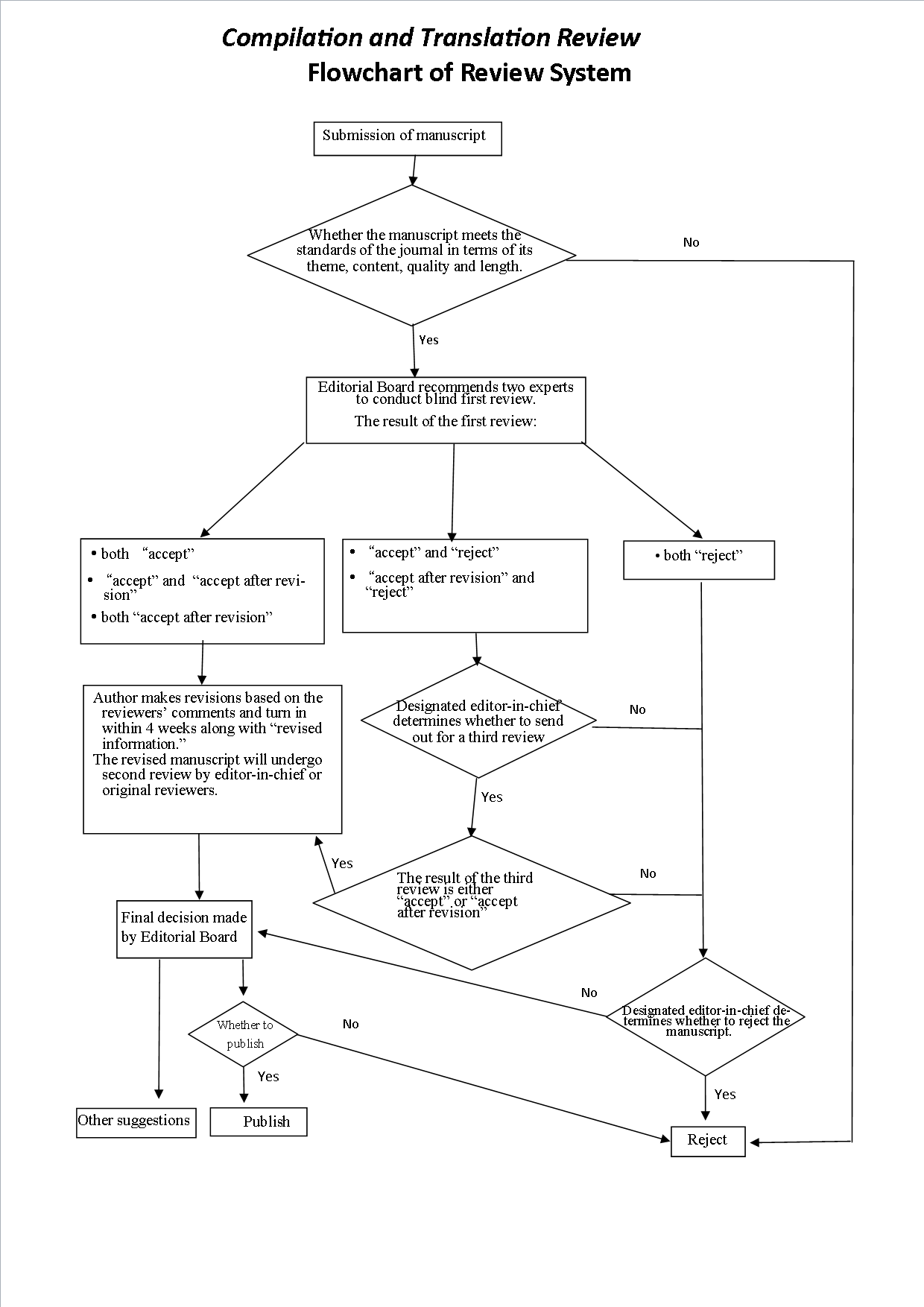Compilation and Translation Review
Review Guidelines
I. Review Process
The review process includes initial screening, first review and second review.
1. Initial Screening
Each manuscript will first undergo initial screening for its theme, content and format to determine whether it will be rejected or sent out for review.
2. First Review
- 2.1 First review results have four categories:
- Accept
- Accept after revision
- Review after revision (original reviewer reviews it again, the result of this review will be the reviewers’ first review result.)
- Reject
- 2.2 When the results of the first two reviewers are as follows:
- (1) Both say “accept”: Editorial Board will further discuss whether to accept the manuscript.
- (2) They say “accept” and “accept after revision”, or both say “accept after revision”: Editorial Board will further discuss whether to accept the manuscript.
- (3) They say “accept” and “reject,” or “accept after revision” and “reject”: The designated editor-in-chief will determine whether the manuscript should be sent to a third reviewer, based on the review comments and the total number of manuscripts submitted. When the manuscript is sent out for a third review, the reviewer will not be notified he/she is the third reviewer, so that the third reviewer can give an unbiased review of the manuscript.
- (4) First two reviewers say “reject”: The manuscript will not be accepted.
3. Second Review
- 3.1 The author needs to turn in the revised manuscript along with “revised information” within four weeks. The second review will be conducted by the designated editor-in-chief or the original reviewers. Suggestions will be provided to the Editorial Board for a final decision.
- 3.2 Should the author be unable to turn in the revised manuscript within four weeks, he/she should notify the Editorial Board and get their consent in advance.
II. Review Guidelines
- 1. According to the topic of the manuscript, the Editorial Board will recommend two experts to conduct double-blind reviews and to avoid reviewers who may be acquainted with the author, such as by kinship, or as student-and-teacher, or as colleagues.
- 2. Review Criteria:
- 2.1 Originality, academic and/or practical value
- 2.2 Data acquisition, usage, and reference; adequacy of interpretation
- 2.3 Research methods and argument (evaluate according to the insights of the article)
- 2.4 Structure of the article, organization of argument, and English and/or Chinese fluency
- 3. Should members of the advisory board and/or editorial board intend to submit manuscripts, they should not be involved in the review process. The designated editor-in-chief also shall not submit a manuscript dealing with issues that he/she is in charge of.
- 4. Compilation and Translation Review adopts a double-blind review policy. All members of the Editorial Board will be responsible for keeping any information about the authors and reviewers confidential.
- 5. An author can submit more than one article for one issue. If two manuscripts by the same author pass the review, the Editorial Board reserves the right to determine the number of articles to be published, and in which issues of the journal they will be published. The author will also be informed of this.
III. Publication
- 1. Manuscripts that pass the first review will be submitted to the Editorial Board for a final decision. The Editorial Board will send “publication certification” to authors whose manuscripts have been accepted; the authors of articles that are rejected will also be notified.
- 2. The designated editor-in-chief may invite experts to submit articles on relevant issues, yet in this case the reviewing process shall still be subjected to the regular review guidelines.
- 3. First reviews for non-academic articles such as forums, book reviews, and translation reviews will be conducted by the designated editor-in-chief or review committee. After the first review, the Editorial Board will determine whether the manuscript can be published.
IV. Withdrawal of Manuscript
- 1. Authors may decide to withdraw their manuscripts either via email or in written form. Manuscripts shall be withdrawn upon confirmation by both parties.
- 2. For manuscripts that are undergoing the first review process, should the author decide to withdraw his/her manuscript, CTR will not accept any further submissions from the author for one year.
V. Rejection of Manuscript
To shorten the waiting time, authors whose manuscripts fail to pass the first review will be informed of this upon the consent of the designated editor-in-chief. Rejection of manuscripts will be reported to the Editorial Board for reference.





